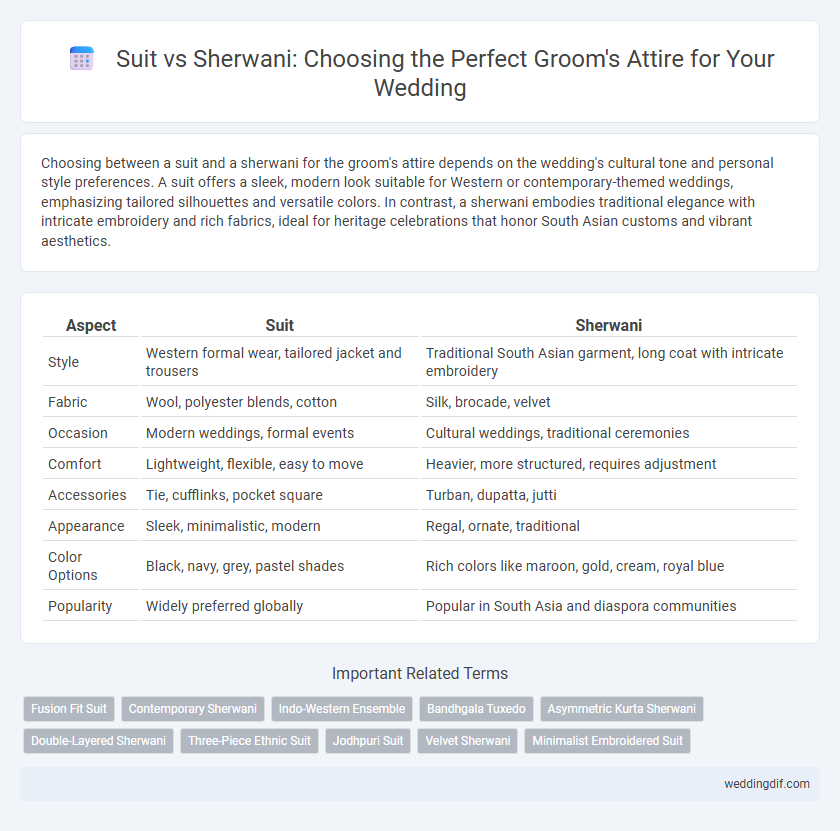Choosing between a suit and a sherwani for the groom's attire depends on the wedding's cultural tone and personal style preferences. A suit offers a sleek, modern look suitable for Western or contemporary-themed weddings, emphasizing tailored silhouettes and versatile colors. In contrast, a sherwani embodies traditional elegance with intricate embroidery and rich fabrics, ideal for heritage celebrations that honor South Asian customs and vibrant aesthetics.
Table of Comparison
| Aspect | Suit | Sherwani |
|---|---|---|
| Style | Western formal wear, tailored jacket and trousers | Traditional South Asian garment, long coat with intricate embroidery |
| Fabric | Wool, polyester blends, cotton | Silk, brocade, velvet |
| Occasion | Modern weddings, formal events | Cultural weddings, traditional ceremonies |
| Comfort | Lightweight, flexible, easy to move | Heavier, more structured, requires adjustment |
| Accessories | Tie, cufflinks, pocket square | Turban, dupatta, jutti |
| Appearance | Sleek, minimalistic, modern | Regal, ornate, traditional |
| Color Options | Black, navy, grey, pastel shades | Rich colors like maroon, gold, cream, royal blue |
| Popularity | Widely preferred globally | Popular in South Asia and diaspora communities |
Introduction: Suit vs Sherwani – Setting the Tone for the Groom
Choosing between a suit and a sherwani for the groom's attire sets the tone for the wedding's cultural and stylistic theme. A suit offers a modern, sleek silhouette ideal for contemporary ceremonies, while a sherwani embodies traditional elegance with intricate embroidery and rich fabrics. The decision influences not only the groom's appearance but also the overall ambiance and formality of the celebration.
Historical Background of Suits and Sherwanis
Suits, originating from 19th-century Europe, evolved from formal military uniforms into contemporary business and formal wear, symbolizing modernity and global influence. Sherwanis, rooted in South Asian aristocracy during the Mughal Empire, reflect regal heritage with intricate embroidery and luxurious fabrics. Choosing between a suit and sherwani for groom's attire highlights a blend of Western modernization and traditional South Asian culture.
Cultural Significance in Modern Weddings
The choice between a suit and a sherwani for the groom's attire reflects evolving cultural significance in modern weddings, where the sherwani symbolizes traditional heritage and regal elegance rooted in South Asian customs. Suits represent contemporary global fashion trends and are favored for their versatility and sleek appearance in diverse wedding settings. Balancing cultural pride and modern style, many grooms opt for either attire to express identity while honoring wedding rituals.
Style and Design Variations
Suit attire for grooms offers sleek, tailored cuts with a variety of fabrics like wool, linen, and velvet, providing modern and versatile style options suitable for both formal and semi-formal weddings. Sherwanis showcase intricate embroidery, traditional motifs, and rich textures such as silk and brocade, embodying cultural heritage with regal and elaborate design variations that often include embellishments like zari and sequins. Style choices between suits and sherwanis depend heavily on the wedding theme, regional customs, and the groom's personal expression of elegance through either contemporary minimalism or ornate tradition.
Comfort and Practicality on the Wedding Day
Choosing a suit for the groom ensures comfort with breathable fabrics and easier movement, making it practical for long wedding ceremonies and receptions. Sherwanis, often heavier and richly embellished, may limit mobility and cause discomfort in warm weather but offer a traditional and royal aesthetic. Prioritizing the wedding climate and duration helps determine whether a lightweight suit or a more ornate sherwani best suits the groom's comfort and functional needs.
Suitability for Different Wedding Themes
A suit offers versatile elegance ideal for contemporary, formal, or semi-formal wedding themes, complementing both indoor and outdoor settings with its sleek silhouette and modern appeal. Sherwani is rooted in traditional Indian and South Asian weddings, providing rich cultural symbolism and intricate embroidery that perfectly suits royal, ethnic, or destination weddings with historical or cultural significance. Choosing between a suit and sherwani depends on the wedding theme's cultural context, venue, and desired ambiance, ensuring the groom's attire harmonizes with the overall celebration.
Accessorizing: Completing the Look
Accessorizing a groom's suit typically involves elegant cufflinks, a crisp pocket square, and a classic tie or bow tie, enhancing the sleek and modern appeal of western formalwear. In contrast, a sherwani calls for traditional accessories like a matching stole or dupatta, ornate brooches, and a turban or safa, which add regal charm and cultural richness to the ensemble. Both styles benefit from polished dress shoes and subtle jewelry, ensuring a completed and sophisticated groom's look.
Factors to Consider: Weather and Season
Choosing between a suit and a sherwani for the groom's attire depends significantly on weather and season; suits made of lightweight fabrics like linen or cotton are ideal for hot and humid climates, ensuring comfort and breathability. Sherwanis, often crafted from heavier materials such as silk or brocade, suit cooler or winter weddings by providing warmth and a regal appearance. Seasonal factors influence not only comfort but also the aesthetic fit of the groom's outfit within the overall wedding theme.
Budget Considerations: Suits vs Sherwanis
Choosing between a suit and a sherwani for groom's attire significantly impacts the wedding budget, with suits generally costing less due to their mass production and availability. Sherwanis, often handcrafted with intricate embroidery and unique fabrics, tend to be more expensive, reflecting the cultural richness and craftsmanship involved. Prioritizing cost-efficiency favors suits, while investing in a sherwani enhances traditional elegance and personalized style for the groom.
Final Thoughts: Choosing the Perfect Groom’s Attire
Opting for a suit offers a timeless, versatile look that complements various wedding themes and venues, while a sherwani provides a rich cultural heritage and regal elegance ideal for traditional ceremonies. Consider the wedding location, personal comfort, and the overall theme to ensure the groom's attire aligns with the event's ambiance. Prioritizing fabric quality, fit, and personal style ensures the groom feels confident and distinguished on his special day.
Suit vs Sherwani for groom's attire Infographic

 weddingdif.com
weddingdif.com